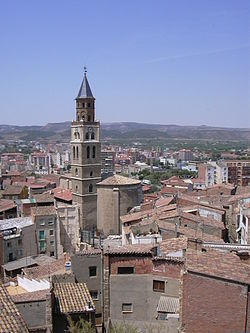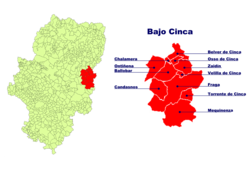Fraga
This article needs additional citations for verification. (November 2018) |
Fraga | |
|---|---|
 | |
 | |
| Coordinates: 41°31′12″N 0°21′0″E / 41.52000°N 0.35000°E | |
| Country | |
| Autonomous community | |
| Province | Huesca |
| Comarca | Bajo Cinca |
| Judicial district | Fraga |
| Government | |
| • Alcalde | Santiago Burgos Sorolla (2022) (PP) |
| Area | |
| • Total | 437.64 km2 (168.97 sq mi) |
| Elevation | 118 m (387 ft) |
| Population ()[1] | |
| Demonyms | Fragatino, -na Fraguense |
| Time zone | UTC+1 (CET) |
| • Summer (DST) | UTC+2 (CEST) |
| Postal code | 22520 |
| Website | Official website |
Fraga (Spanish: [ˈfɾaɣa] ; Catalan: [ˈfɾaɣɛ]) is the major town of the comarca of Bajo Cinca (Catalan: Baix Cinca) in the province of Huesca, Aragon, Spain. It is located by the river Cinca. According to the 2014 census,[2] the municipality has a population of 14,926 inhabitants.
King Alfonso I of Aragon died at its walls in 1134 while trying to conquer it during the Battle of Fraga. It was conquered from the Moors by the Count Ramon Berenguer IV of Barcelona in 1149.
The local language, called Fragatí, is western Catalan.
Historically, there was a Jewish community in Fraga. Jews in Fraga enjoyed civil rights, which was not always the case in other historical Spanish Jewish communities. They were given autonomy, including the right to defend themselves against attacks and the right to elect their representatives. The community ceased to exist due to the expulsion of the Jews in 1492.[3]
History
-
Plan of western view of Fraga circa 1779 by Bernardo Espinalt y García
Sights
Spanish Civil War
The town was controlled by anarcho-syndicalists associated with CNT during the Spanish Revolution of 1936. They carried out collective farming, price controls, wartime rationing, interest-free banking, sanitation programs, public works, tree planting and the establishment of a nursing home. The town hospital was enlarged from 20 beds to 100, and running water was provided to the hospital for the first time to combat Typhus.[4]
Demography
Population evolution along the years
<timeline> ImageSize = width:650 height:300 PlotArea = width:450 height:230 left:180 bottom:35 AlignBars = late
DateFormat = yyyy Period = from:0 till:15000 TimeAxis = orientation:vertical ScaleMajor = unit:year increment:1000 start:0
BarData=
bar:1910 text:"1910" bar:1920 text:"1920" bar:1930 text:"1930" bar:1940 text:"1940" bar:1950 text:"1950" bar:1960 text:"1960" bar:1971 text:"1971" bar:1981 text:"1981" bar:1991 text:"1991" bar:1994 text:"1994" bar:1996 text:"1996" bar:2001 text:"2001" bar:2004 text:"2004" bar:2006 text:"2006" bar:2013 text:"2013" bar:2018 text:"2018"
PlotData=
width:15 bar:1910 color:brightblue from:0 till:6899 bar:1920 color:brightblue from:0 till:7063 bar:1930 color:brightblue from:0 till:7497 bar:1940 color:brightblue from:0 till:7397 bar:1950 color:brightblue from:0 till:6817 bar:1960 color:brightblue from:0 till:7264 bar:1971 color:brightblue from:0 till:8691 bar:1981 color:brightblue from:0 till:10013 bar:1991 color:brightblue from:0 till:10955 bar:1994 color:brightblue from:0 till:11491 bar:1996 color:brightblue from:0 till:11783 bar:2001 color:brightblue from:0 till:12100 bar:2004 color:brightblue from:0 till:13035 bar:2006 color:brightblue from:0 till:13191 bar:2013 color:brightblue from:0 till:14834 bar:2018 color:brightblue from:0 till:14979
</timeline>
| Population trend between 1991 and 2018 | ||||||
|---|---|---|---|---|---|---|
| 1991 | 1996 | 2001 | 2004 | 2006 | 2013 | 2018 |
| 11491 | 11783 | 12100 | 13035 | 13191 | 14834 | 14979 |
Notable People
- Astruc Remoch, prominent converso and critic of Judaism
- Ceferino Giménez Malla, Spanish Romani activist
- Lourdes Casanova, notable academic
See also
- Bajo Cinca/Baix Cinca
- Grace Fraga (Actress Comedian)
- Florida 135, oldest nightclub in Spain
References
External links
- Pages with non-numeric formatnum arguments
- Articles needing additional references from November 2018
- All articles needing additional references
- Short description with empty Wikidata description
- Coordinates not on Wikidata
- Pages with Spanish IPA
- Pages with Catalan IPA
- Articles containing Catalan-language text
- Pages using Lang-xx templates
- Commons link is defined as the pagename
- Municipalities in the Province of Huesca
- La Franja












